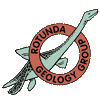This was an excellent talk pitched at the right level. Paul summarised the key facts about the phylum. All species are colonial suspension feeders, almost all marine. The hard parts are used in classifying both recent and fossil forms. The colony is a clone and is of modular construction, tubes or boxes repeated to give a great variety of shapes producing chains, sheets, domes, and dendritic, folaceous and fan-shaped structures.
Recent bryozoa are familiar as Horn Wrack, Flustra foliacea, and an anticancer drug, bryostatin, is obtained from Bugula neritina.
The Bryozoa evolved rapidly in the Ordovician and were important during the rest of the Palaeozoic, suffering a major decline at the end of the Permian. Survivors evolved slowly through the Triassic and Jurassic and from the Late Cretaceous cheilostomes became the dominant group.
The skeleton reflects adaptations to efficient filter feeding. Monticules are raised areas forming exhalent chimneys. Holes called fenestrules present in Carboniferous and Permian fenestellid bryozoan colonies for the outflow of filtered water evolved again cyclostomes and cheilstomes in the Mesozoic and Cenozoic, respectively. Bryozoans are predated by nudibranchs, echinoids, pycnogonids and fish: they defend themselves by secreting hard skeletons, including spines, and through toxic chemicals. Some individuals are modified into snapping beaks, avicularia, which have a powerful grip. Reproduction and dispersal is by ciliated larvae. Brood chambers (ovicells) in cheilostome are made by the neighbours of the zooids producing the eggs.
Competition between bryozoan colonies is mainly for living space rather than food. Spines at the edge of the colony discourage overgrowth although larger zooids tend to win over smaller ones and cheilostomes over cyclostomes. Remarkable fossil evidence of soft-bodied bryozoans has been preserved as moulds on the undersides of overgrowing species that have hard skeletons.
